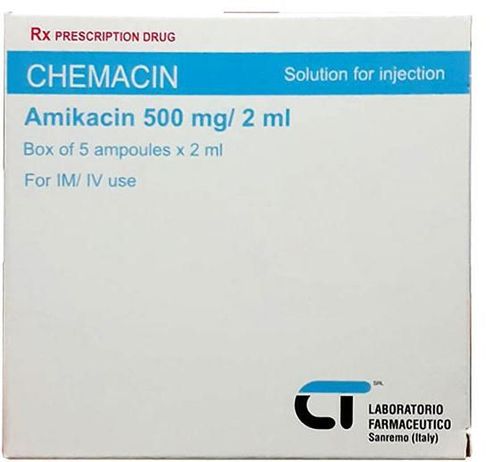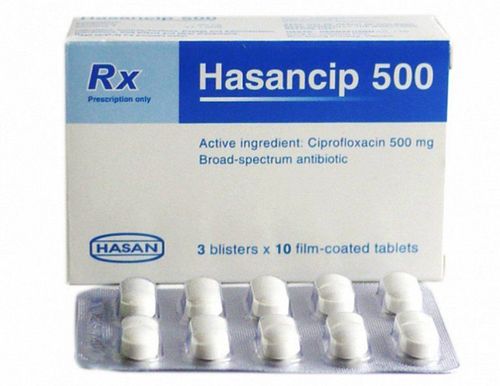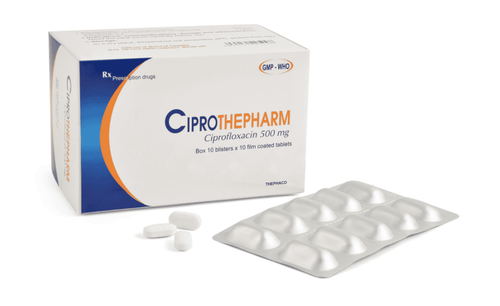This is an automatically translated article.
Cloxacillin 1g is an antibiotic with bactericidal effect. The drug causes inhibition of bacterial cell wall synthesis such as Benzylpenicillin, but is resistant to Staphylococcus penicillinase.
1. Effects of the drug Cloxacillin 1g
1.1. Pharmacology and mechanism of action of the drug Cloxacillin 1g Cloxacillin 1g is a penicillinase-resistant bactericidal antibiotic of the penicillinase group. The drug has an inhibitory effect on bacterial cell wall synthesis such as Benzylpenicillin, but is resistant to Staphylococcus penicillinase. Therefore, Cloxacillin 1g is active against penicillinase-producing or non-penicillinase-producing Staphylococcus with a minimum inhibitory concentration of about 0.25 - 0.5 microgram/ml. After oral administration of a dose of 500 mg, Cloxacillin drug concentrations 1g reached peak plasma levels from 7-14 micrograms/ml fasting, after 1-2 hours. Absorption is better if administered intramuscularly and after a single dose of 500 mg, peak plasma concentrations are reached about 15 micrograms/ml within 30 minutes. When the therapeutic dose is doubled, the plasma concentration of the active substance is also doubled. Cloxacillin 1g crosses the placenta and is secreted in breast milk. The drug is less likely to diffuse into the cerebrospinal fluid unless the meninges are inflamed. Therapeutic drug concentrations can be achieved in pleural fluid, synovial fluid and in bone. Cloxacillin 1g is metabolized to a limited extent. Unmodified drug and metabolites are excreted in the urine by glomerular filtration and tubular secretion. Approximately 35% of an oral dose is excreted in the urine and up to 10% in the bile. 1.2. Pharmacokinetics of the drug Cloxacillin 1g Absorption: Oral cloxacillin sodium is not completely absorbed from the gastrointestinal tract and is further reduced with food in the stomach. Completely absorbed after intramuscular injection and after a single dose of 500 mg. Distribution: Approximately 94% of the circulating drug Cloxacillin is bound to plasma proteins. Cloxacillin crosses the placental barrier and is excreted in breast milk. Metabolism: Cloxacillin is metabolized to a limited extent. Unmodified drug and metabolites are excreted mainly in the urine in the renal tubules. Elimination: Approximately 35% of a therapeutic dose of Cloxacillin 1g orally is excreted in the urine and up to 10% in the bile. 1.3. Effects of Cloxacillin 1g Drug Cloxacillin 1g is a bactericidal antibiotic, inhibiting bacterial cell wall synthesis such as Benzylpenicillin, but resistant to Staphylococcus penicillinase.
2. What disease does Cloxacillin 1g treat?
Cloxacillin 1g Injection is used to treat severe infections caused by penicillinase-producing Staphylococcus when high plasma concentrations are required, including bone and joint infections, endocarditis, and peritonitis (in combination with dialysis. continuous outpatient peritoneal), pneumonia, dermatological diseases (including soft tissue infections), surgical infections (prophylaxis). Cloxacillin 1g orally should not be used for the initial treatment of serious life-threatening infections. But the doctor can prescribe it after the penicillinase-resistant penicillin has been administered by injection. Do not use Cloxacillin 1g orally in the treatment of meningitis.3. Usage and dosage of Cloxacillin 1g
3.1. How to take Cloxacillin 1g Cloxacillin 1g is usually used orally or injected as sodium salt. You should take Cloxacillin 1g before eating 1 hour or at least 2 hours after eating because food in the stomach reduces drug absorption.
3.2. Usual therapeutic dose Tablet form:
Take Cloxacillin 1g before eating 1 hour or 2 hours after eating; Adults: 250-500mg/6 hours; Children weighing less than 20kg: 12.5-25mg/kg/6 hours. Injection form:
Intramuscular or intravenous injection; Adults and children weighing less than 20kg: 500mg/time, 3-4 times/24 hours; Children weighing less than 20kg: 50-100mg/kg/24 hours, divided into 3-4 times.
4. Undesirable effects of Cloxacillin 1g
Undesirable effects of Cloxacillin 1g injection are most commonly hypersensitivity reactions, especially skin rash, sometimes with anaphylaxis. People with kidney failure are also at high risk. A common side effect is a rash (about 4% of people taking Cloxacillin 1g injection). For people taking Cloxacilin, the most common side effects are gastrointestinal signs and symptoms that depend on the dose taken. Common adverse effects with ADR > 1/100: Gastrointestinal: Nausea or diarrhea. Skin: External rash. Other: Thrombophlebitis after intravenous infusion. Uncommon side effects with 1/1000 < ADR < 1/100: Skin: Appearance of urticaria. Blood: Eosinophilia increased. Rare adverse effects with ADR < 1/1000: Systemic: Anaphylactic reaction. Blood: Agranulocytosis or leukopenia. Gastrointestinal: Pseudomembranous colitis. Liver: Cholestatic jaundice. Urogenital - Genitourinary: Renal dysfunction accompanied by elevated serum creatinine. Note: Pseudomembranous colitis is caused by Clostridium difficile overgrowth and toxins. May be treated with metronidazole. Elderly people or those who are prone to diseases need to be very cautious about this undesirable effect.
5. Cloxacillin drug interactions 1g
As with other Penicillins, mixing Cloxacillin 1g with Aminoglycosides in vitro will significantly inactivate each other. If it is necessary to use a combination of these two antibiotics, they must be injected at two different sites, at least 1 hour apart. Concomitant use of high doses of Cloxacillin 1g with anticoagulants (Coumarin, Indandion derivatives or Heparin) may increase the risk of bleeding. Because penicillin inhibits platelet aggregation, careful monitoring is required for signs of bleeding. Cloxacillin 1g should not be used with thrombolytics because it may increase the risk of major bleeding. Probenecid reduces renal tubular secretion of penicillins and increases the risk of toxicity if co-administered. Aminoglycoside antibiotics should not be mixed with Cloxacillin 1g as well as with beta - lactam antibiotics, because it inactivates each other in vitro. If combination therapy is indicated, the drug must be injected at two different sites, at least 1 hour apart. Cloxacillin 1g should also not be used with Tetracycline antibiotics, Erythromycin and Polymyxin B sulfate.
6. Some notes when using Cloxacillin 1g
Use of Cloxacillin 1g for women who are pregnant and breastfeeding:
Pregnancy The safe use of Cloxacillin 1g during pregnancy has not been established. Therefore, cloxacillin should be used during pregnancy only when clearly needed. Lactation: Since Cloxacillin 1g is distributed into breast milk, this drug should be administered to a nursing mother with extreme caution. There are no specific reports on the effects of Cloxacillin 1g on the ability to drive and use machines. However, to be on the safe side, you should consult your doctor before using it.
Above are the uses, dosage and usage of Cloxacillin 1g. Drugs are prescribed depending on the cause of the disease and the condition of each patient. It is best to consult a doctor before use to ensure safety for health..
Please dial HOTLINE for more information or register for an appointment HERE. Download MyVinmec app to make appointments faster and to manage your bookings easily.













